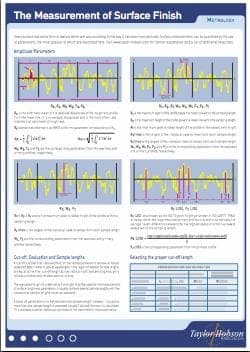
Curated with aloha by
Ted Mooney, P.E. RET

The authoritative public forum
for Metal Finishing 1989-2025

-----
Conversion from Pt to Ra
August 29, 2013
Q. I have a component dimensioned as 0.0025-/ Pt 20. But same surface for similar part dimensioned as Ra 1.6. I don't know which is a smoother surface.
Can anybody help me how to convert 0.0025-/ Pt 20 to Ra 1.6?
And what is the difference between Pt and Ra parameters of surface roughness.
Hydraulic Cartridge Valve - India
A. Hi Karthikeyan,
Rt (equals Pt) and Ra measure surface roughness in different way and can't simply convert from one to another.
Ra represents arithmetic mean surface roughness which is arithmetical mean of the sums of all profile values.
Rt represents total height of the roughness profile which is sum from the height of the highest profile peak and the depth of the lowest profile valley within the measured length.
Regards,
David

David Shiu
- Singapore
December 25, 2013
A. Hi Karthikeyan. Roughness scales can't be "converted" one to another because they are measuring different things; but some people do sometimes note that one parameter may "track" another if a large enough safety factor is employed.
Even still, those "tracking" conversions are dangerous. A practical example I like to note on this finishing site is the observation that modern nickel plating solutions can offer a bright finish on roughly polished steel because they "level" it ... and yet nickel plating will emphasize a large scratch rather than filling it in. So it is useful to have a roughness scale that measures whether a finish is smooth enough for nickel plating to level it; but that roughness scale might not be useful for determining whether a hydraulic seal will be able to function leak-free against a given surface. There is no real "conversion" between whether a finish will level out well during nickel plating vs. how much fluid leakage should be anticipated if an o-ring is run against it instead.
Regards,

Ted Mooney, P.E. RET
Striving to live Aloha
finishing.com - Pine Beach, New Jersey
December 2013
Difference between Pt and Rz surface measurements
July 22, 2015Q. Can anybody explain in detail what is the difference between Pt and Rz roughness parameters?
RAJ BIRADARJOB - PUNE, MAHARASHTRA India
A. Probably not, Raj :-)
I don't like the subject of surface roughness ... because people, including myself, want to talk about the subject and get "answers" without putting in the many long hours necessary to acquire the basics. So we jump into it with a half-baked understanding, and without having acquired the requisite vocabulary and intuitive feel, and then all just confuse each other :-)
Further, surface profiles are sometimes listed in English units, sometimes in metric, without a clear indication of the units employed. And there are dozens of different surface roughness parameters which cannot be converted from one to the other because they measure different things, yet they often "track" each other like the average weight of people tracks their average height -- so people try to offer "safe" conversion factors from one parameter to the other, making things worse.
Anyway ... my understanding is that Pt is the same as Rt except that it applies to the measured primary profile, and ignores the "waviness" of the overall surface. Thus it is the maximum peak to valley height within the "assessed" length, usually 5 sample lengths.
Rz [old Rz, not the new ISO Rz(JIS)] is the maximum peak to valley height within the "sample" length as opposed to the assessed length. Thus it seems to me that Pt could be equal to Rz if the maximum depth and height which can be found within the assessed length happened to occur within a single sample length, but that usually Pt will exceed Rz. Is it all perfectly clear now? :-)
Regards,

Ted Mooney, P.E. RET
Striving to live Aloha
finishing.com - Pine Beach, New Jersey
September 4, 2017
Q. In roughness parameter, what is the meaning of 0.0025/pt25, and which cut off length we used for measure this roughness.
Himanshu kaushik- Gurgaon, haryana, India
Q, A, or Comment on THIS thread -or- Start a NEW Thread
